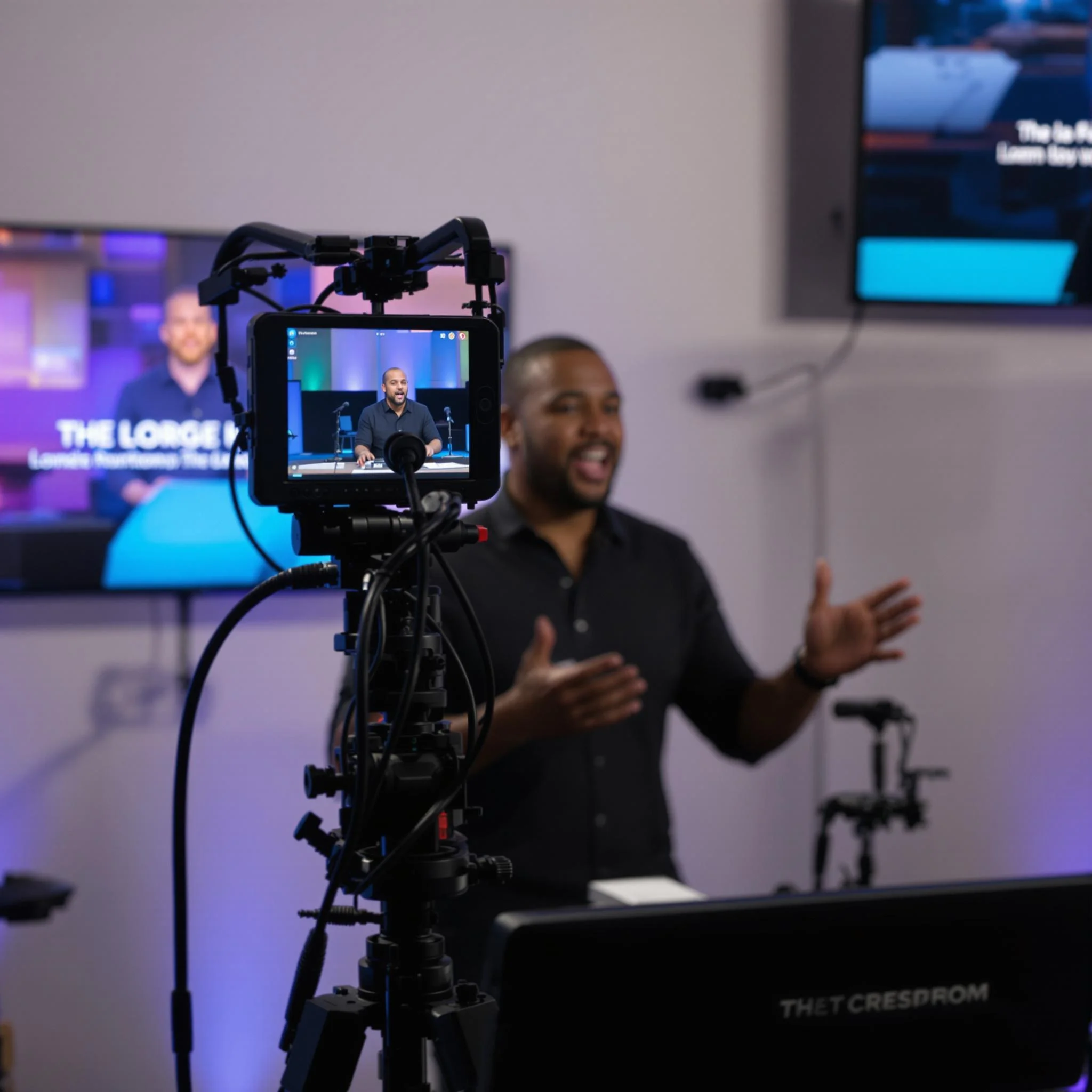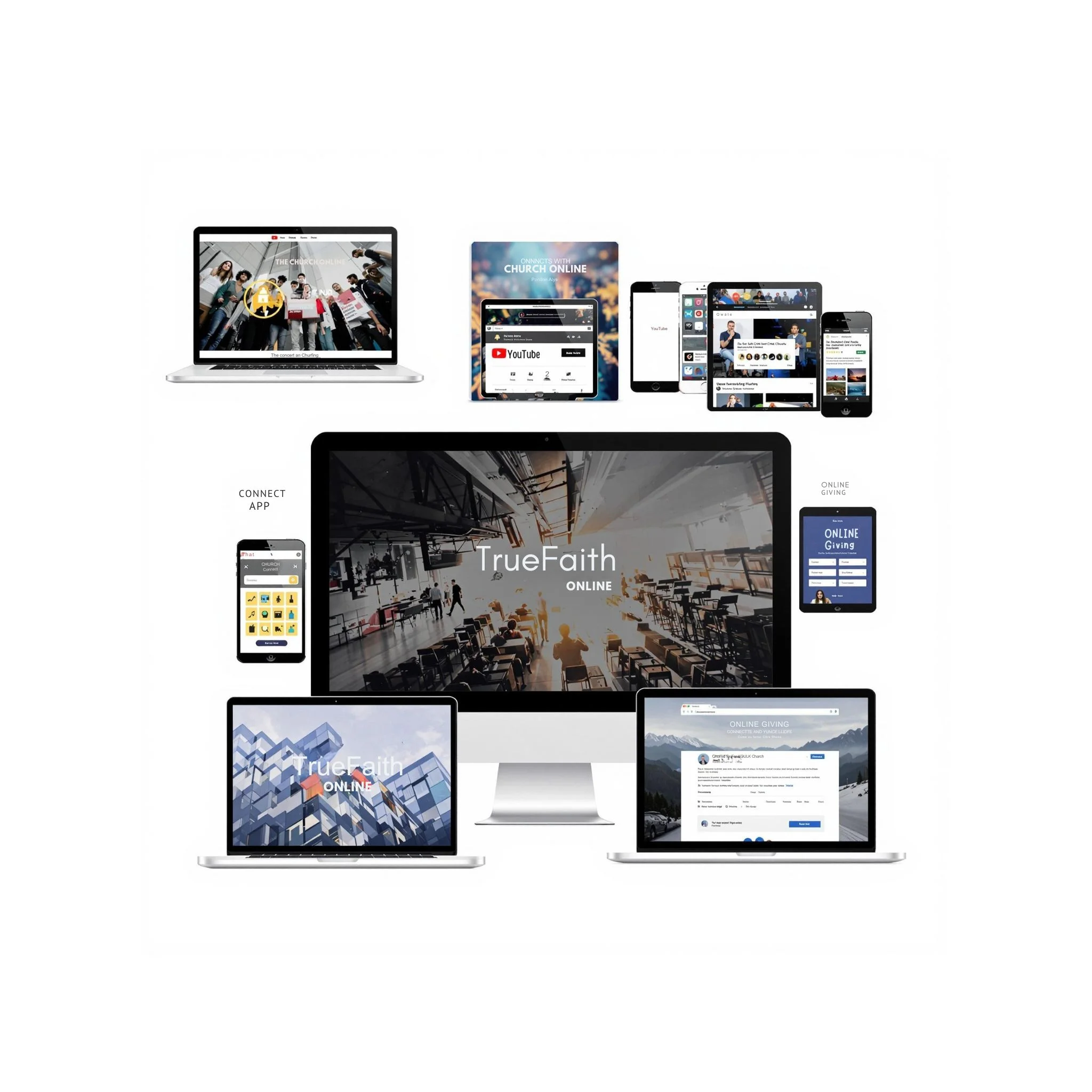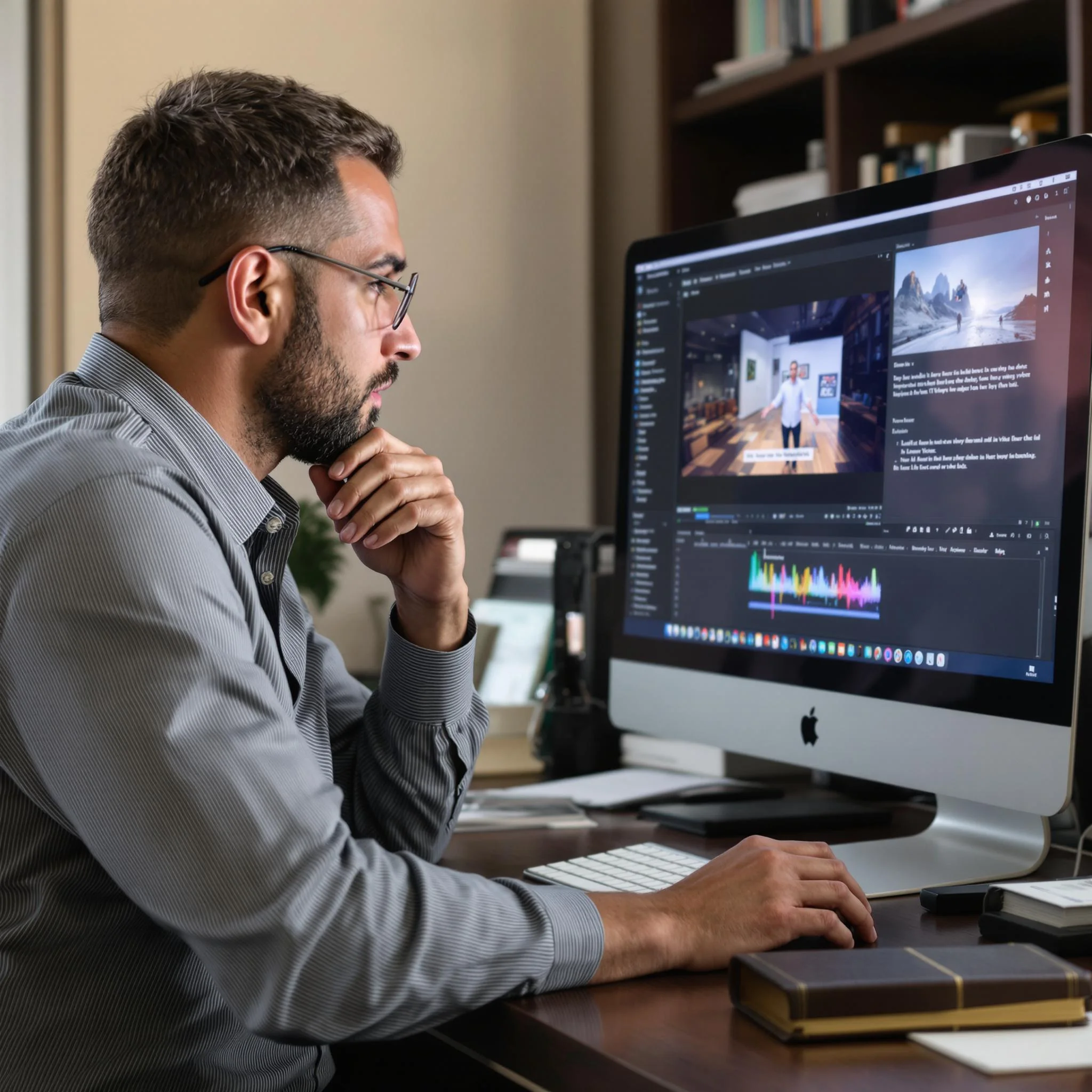Digital Ministry Strategy: Empowering Your Church Mission in the Digital Age
Key Takeaways
- Digital ministry uses technology to extend church activities beyond physical boundaries
- A strong digital strategy helps churches reach wider audiences and deepen connections
- Essential platforms include church websites, social media, live streaming, and mobile apps
- Effective digital ministry requires both technical skills and authentic spiritual content
- Digital tools should complement in-person worship, not replace meaningful connections
- Churches face challenges like the digital divide and resistance to technological change
Digital ministry wasn't really a thing many churches thought about until COVID forced our hand. As a pastor who once thought "online church" meant just recording the Sunday service, I've learned so much these past few years. Making a digital strategy ain't just about posting sermons online—it's about creating real connections in virtual spaces.

Modern digital ministry tools enable churches to reach beyond their physical walls
What is a Digital Ministry Strategy?
Defining Digital Ministry
Digital ministry uses technology to do church stuff online. Think worship services, Bible studies, prayer groups, and outreach—but through screens instead of in-person. It's not just about having a Facebook page or YouTube channel. It's about using these tools with purpose to help people grow spiritually, no matter where they are.
I remember when our church first tried live streaming. We put an iPhone on a tripod and hoped for the best! Now we've got a proper setup, but the goal hasn't changed: connecting people to God and each other.
Importance of a Digital Strategy for Churches
Do you need a digital strategy? Yes, you do. Here's why:
- People expect to find you online before they visit in person
- Members who can't attend physically still want to participate
- Young people especially connect through digital channels
- Ministry can happen 24/7, not just on Sunday mornings
- Your reach extends far beyond your local community

Digital ministry allows families to participate in worship from anywhere
Key Components of a Digital Ministry Strategy
| Component |
Purpose |
Examples |
| Planning & Setup |
Create foundation and direction |
Mission statement, goals, tech inventory |
| Content Creation |
Develop meaningful materials |
Sermons, devotionals, Bible studies |
| Distribution |
Share content effectively |
Website, email, social media |
| Community Engagement |
Foster connections |
Online groups, interactive elements |
| Digital Outreach |
Reach new people |
Targeted content, online events |
| Analytics |
Measure effectiveness |
Engagement metrics, feedback systems |
| Adaptation |
Improve continually |
Regular reviews, staying current |
How Can Digital Strategies Enhance Church Engagement?
Using Digital Tools for Worship Services
Worship doesn't have to stop when people can't make it to the building. We've found these digital worship tools super helpful:
- Live streaming: Sunday services, midweek Bible studies
- Interactive prayer walls: Where people post requests and pray for others
- Digital communion: Guiding at-home communion during online services
- Chat features: For real-time connection during live events
- Service archives: So people can watch when it works for them
One Sunday, our stream went down for 10 minutes—I was panicking! But afterwards, people told me they just used the time to pray together in their homes. That taught me something important: digital tools help, but faith happens with or without perfect technology.

A church tech team collaborating to create engaging online worship experiences
Creating an Online Community for Your Congregation
Building community online is hard but worth it. You gotta be intentional. Here are some ways we've found to create real community in digital spaces:
- Small groups that meet via video chat
- Private Facebook groups for different ministries
- Digital coffee hours after online services
- Prayer partners connected through messaging apps
- Virtual game nights and social events
The secret? Make sure there's two-way communication. Nobody wants to just consume content—they wanna participate and be known.
Best Practices for Engaging Members Virtually
After trying tons of different approaches, these best practices seem to work best:
| Practice |
Why It Works |
| Consistent posting schedule |
Creates reliable touchpoints people can count on |
| Responding to comments quickly |
Shows people they're being heard and valued |
| Asking questions in posts |
Encourages interaction and discussion |
| Incorporating user-generated content |
Makes members feel ownership of the ministry |
| Celebrating milestones publicly |
Creates shared moments of community joy |
| Varying content formats |
Reaches different learning and engagement styles |
Exploring Popular Digital Platforms for Ministry
There's so many platforms out there—it gets overwhelming! You don't need to be on all of them. Pick the ones that make sense for your congregation.

Churches can leverage multiple platforms to reach different audience segments
Utilizing Social Media for Outreach and Engagement
Social media can be your best friend or biggest time-waster. Use it smart, not just to broadcast but to actually connect.
We tried posting the same content on every platform and got crickets. Then we got smarter about each platform's strengths:
- Facebook: Great for events, groups, and reaching older adults
- Instagram: Visual content, behind-the-scenes, reaching younger adults
- TikTok: Creative, short-form content for youth and young adults
- Twitter/X: Quick updates, links, and conversations on current topics
My favorite success story? Our youth pastor started doing 30-second Bible insights on TikTok. I thought it was silly until parents told me their teenagers were suddenly asking questions about Scripture at dinner!
Choosing the Right App for Your Church's Needs
Do you even need a church app? Maybe not, if your website works great on mobile. But a good app can bring everything together in one place. When choosing, think about:
- What features do your people actually want?
- Can you maintain it long-term?
- Does it integrate with your church management system?
- Is it affordable for your budget?
- How easy is it for non-tech people to use?
We tried three different apps before finding one that stuck. The winner wasn't the one with the most features—it was the one people actually used because it was simple and solved real problems.
How to Create a Content Strategy for Digital Ministry?
Developing Engaging Digital Content
Content is king, but engagement is queen—and she rules the house! Your content needs to be:
- Relevant to real-life situations
- Authentic to your church's voice and values
- Varied in format (text, images, video, audio)
- Accessible to different tech comfort levels
- Consistent but not boring

Creating engaging digital content requires both technical skills and spiritual depth
I used to spend hours perfecting every word of a blog post nobody read. Now I spend that time understanding what questions our people are actually asking, and answering those instead.
Incorporating Scripture into Your Digital Offerings
Scripture should be the foundation of your digital ministry, not an afterthought. Some effective ways to center Scripture include:
| Digital Offering |
Scripture Integration Ideas |
| Social Media |
Verse graphics, short video expositions, themed series of related passages |
| Website |
Daily verse feature, Bible reading plans, searchable sermon archive by passage |
| Email |
Weekly devotionals, Scripture reflection prompts, Bible study previews |
| Videos |
On-screen text, deeper passage exploration, contextual background |
| Interactive |
Bible trivia, verse memorization challenges, guided Scripture meditation |
Don't just quote Scripture—help people understand and apply it. That's where the real transformation happens.
Content Creation Ideas for Worship Online
Online worship should be more than just pointing a camera at what you'd do in person. Think digital-native! Try these content ideas:
- Shorter, focused services (30-45 minutes works better online)
- Interactive elements that work through screens (polls, responsive readings)
- Guided worship moments for home settings ("find an object that represents...")
- Digital communion guides for families to follow together
- Collaborative worship elements (submitting prayers, photos, testimonies)
- Worship music designed for smaller speakers and home environments
Our most powerful online worship moment? We asked everyone to light a candle at home during a prayer vigil. Seeing hundreds of candles appear in people's homes—it felt like we were together even though we were apart.
What Are the Challenges of Digital Ministry?
Addressing Digital Divide and Accessibility Issues
Not everyone has the same access to technology, and we can't leave people behind. Common challenges include:
- Elderly members without internet or devices
- Low-income families with limited data or connectivity
- Rural areas with poor internet infrastructure
- People with disabilities needing accommodations
- Language barriers in digital interfaces
We had to get creative. For some folks, we set up phone trees where they could listen to service audio. For others, we created tech buddy systems, pairing tech-savvy members with those needing help. It wasn't perfect, but it showed everyone mattered.
Maintaining Authenticity in Virtual Worship
Online worship can sometimes feel like a TV show instead of a sacred gathering. How do we keep it real? This question has kept me up at night more than once.
- Don't try to be perfect—embrace the humanity and occasional technical glitches
- Create moments that invite participation, not just passive viewing
- Be yourself—the same person online as you are in person
- Focus on relationship more than production quality
- Remember that worship is about God, not entertainment
One Sunday our keyboard player's mic wasn't working, and viewers could see her playing but couldn't hear anything. Later people told me they loved watching her worship so sincerely even when she couldn't be heard. That taught me authenticity resonates even through technical problems.
Overcoming Resistance to Digital Transformation
Change is hard, and digital ministry represents big change for many churches. You'll likely hear things like:
- "Real ministry happens face-to-face"
- "We'll lose our sense of community"
- "Our older members will be left behind"
- "It's too expensive/complicated/time-consuming"
- "We're just not a tech-savvy church"
These concerns are valid. Don't dismiss them. Instead, start small, show results, and involve skeptics in the process. Our most vocal digital ministry critic eventually became our livestream director after we patiently brought him along!
Training and Resources for Ministers
Most ministry leaders didn't go to seminary to become digital content creators! They need training and support. Useful approaches include:
| Resource Type |
Benefits |
Examples |
| Hands-on Workshops |
Practical skills development with immediate feedback |
Video editing basics, social media management, livestream setup |
| Peer Learning Groups |
Shared experiences and collaborative problem-solving |
Monthly digital ministry cohorts, denominational tech teams |
| Online Courses |
Self-paced learning on specific platforms or skills |
YouTube tutorials, LinkedIn Learning, ministry-specific courses |
| Tech Buddies |
Personal support from more experienced users |
Pairing tech-savvy members with ministry leaders |
| Resource Libraries |
Ready-to-use templates and materials |
Social media graphics, email templates, policy documents |
We made a huge mistake at first—dumping new tech on our staff without proper training. Now we have a "no new tool without training" rule, and it's made all the difference.
Encouraging Innovation in Ministry Strategies
Innovation doesn't happen by accident. You gotta create space for it. Try these approaches:
- Set aside "experimental" budget with permission to fail
- Celebrate creative attempts, not just successes
- Create cross-generational innovation teams
- Visit or virtually connect with innovative churches
- Ask "what if?" questions regularly in planning meetings
I remember when our youth pastor wanted to try TikTok devotionals. Some leaders thought it was silly, but we gave her a green light. Six months later, those 60-second videos had more engagement than anything else we were doing. Sometimes you just gotta try stuff!
Building a Supportive Network for Digital Ministry
Nobody should do digital ministry alone. It's too complex and changes too fast. Build these networks:
- Internal digital ministry team with diverse skills and perspectives
- Connections with other churches doing similar work
- Relationships with digital ministry experts and consultants
- Denominational or network resources and communities
- Prayer partners specifically focused on digital ministry
Our best decisions have come from our monthly digital ministry team meetings. We've got teenagers and retirees, tech pros and newbies. The diversity of perspectives catches blind spots none of us would see alone.
What is the Future of Digital Ministry?
Trends in Digital Worship and Engagement
The digital ministry landscape keeps changing. Here's what's coming next:
- Hybrid Everything: Seamlessly connecting physical and digital experiences
- AI-Enhanced Ministry: Using artificial intelligence for personalized spiritual growth
- Immersive Experiences: VR/AR for Bible stories and worship environments
- Micro-Content: Ultra-short, highly engaging spiritual content for busy lives
- Global Collaborations: Churches partnering across borders and languages
- Digital-First Ministries: Communities born online that may never meet physically
Some of this makes me nervous, I'll admit. But I've learned that technology itself isn't good or bad—it's how we use it that matters.
Preparing for the Next Steps in Digital Ministry
How do you prepare for a future that's changing so fast? Focus on these fundamentals:
- Build adaptable systems rather than rigid plans
- Invest in people's digital skills more than specific platforms
- Stay curious about emerging technologies without chasing every trend
- Keep theological reflection at the center of your digital strategy
- Balance innovation with sustainability
I've stopped asking "What's the best platform?" and started asking "What's the best way to love and serve people right now?" That question never goes out of date.
Embracing the Great Commission in a Digital Age
Jesus said go to all nations and make disciples. He didn't specify the transportation or communication method! Digital tools give us unprecedented ways to fulfill the Great Commission:
- Reaching people who would never enter a church building
- Crossing geographical, political, and cultural barriers
- Creating 24/7 access points to the gospel message
- Discipling people through interactive, on-demand resources
- Equipping believers to share their faith digitally
A woman in our church reconnected with her cousin across the country through our online Bible study. Her cousin would never have visited a physical church, but she felt safe trying it online. Six months later, she was baptized in her local river while our congregation watched via livestream. That's the Great Commission in action!
Digital ministry isn't just about technology—it's about people. It's about using every tool available to share God's love, build meaningful community, and make disciples. The platforms will change, but the mission remains the same.
Frequently Asked Questions
Do small churches need a digital ministry strategy?
Yes! Even the smallest churches can benefit from some digital presence. Start simple with the platforms your congregation already uses. Even a basic Facebook page, WhatsApp group, or email newsletter can greatly enhance connection and outreach.
How much should we budget for digital ministry?
This varies widely depending on your goals. You can start with free tools and volunteer help, or invest thousands in professional equipment and staff. A good starting point is 5-10% of your total ministry budget, increasing as you see results.
Is online church "real" church?
This theological question continues to be debated. Most churches now recognize that meaningful worship, community, and discipleship can happen online, even while acknowledging that physical gathering has unique value. The key is fostering authentic connection and spiritual formation, regardless of the medium.
How do we measure success in digital ministry?
Look beyond simple metrics like views and likes. Better indicators include active engagement (comments, shares), relationship development, spiritual growth stories, and real-world actions resulting from digital engagement. Ask: "Are lives being transformed?"
What's the biggest mistake churches make with digital ministry?
Treating digital platforms as mere broadcasting tools rather than relationship-building spaces. One-way communication misses the relationship potential of digital ministry. Always aim for conversation and community, not just content distribution.
How do we protect privacy and security in digital ministry?
Develop clear policies about what information is shared, who has access to accounts, and how prayer requests are handled. Use secure platforms, especially for sensitive pastoral care. Train all volunteers on privacy best practices and regularly review your security measures.
